Iron tsuba of mokkō form (mokkōgata) pierced (sukashi) and inlaid with precast dark brass inlay (taka-zōgan) with somewhat abstract/geometrical design that can be liberally described as pines, mist, and snow.
Momoyama or early Edo period. End of the 16th - beginning of the 17th century. Heianjō school. Unsigned. Dimensions: 86.8 x 82.9 x 4.5 mm.-

-
 Iron tsuba of almost round form with a brass outlined circular opening (sukashi) in the bottom adorned with the Myriad Treasures [takaramono, 宝物] and winter motifs inlaid in cast brass (suemon-zōgan); hitsu-ana possibly cut later, both plugged with shakudo, nakaga-ana fitted with copper sekigane. According to Merrily Baird*) (2001), the symbolism of Myriad Treasures “is associated with the Seven Gods of Good Luck, who carry them in a sack”. Among the treasures, which are said to ensure prosperity, long life, and general good fortunes, are (reading clockwise from the top):
Iron tsuba of almost round form with a brass outlined circular opening (sukashi) in the bottom adorned with the Myriad Treasures [takaramono, 宝物] and winter motifs inlaid in cast brass (suemon-zōgan); hitsu-ana possibly cut later, both plugged with shakudo, nakaga-ana fitted with copper sekigane. According to Merrily Baird*) (2001), the symbolism of Myriad Treasures “is associated with the Seven Gods of Good Luck, who carry them in a sack”. Among the treasures, which are said to ensure prosperity, long life, and general good fortunes, are (reading clockwise from the top):- Sake set [shuki, 酒器], namely flask, ladle, and cups
- Cloves [choji, 丁子]
- Purse of inexhaustible reaches [kinchaku, 巾着]
- Magic mallet [kozuchi, 小槌]
- Key to the storehouse of the Gods [kagi, 鍵]
- Rhombus, or Lozenge (hosho, 方勝), with the second ideograph meaning victory.
- Sacred (or wish-granting) gem, or jewel [hōju, 宝珠]
- Hats of invisibility [kakuregasa, 隠れ笠]
-
 A pair of copper menuki in the form of a shrimp (lobster, crawfish, ebi) with eyes inlaid in shakudō.
A pair of copper menuki in the form of a shrimp (lobster, crawfish, ebi) with eyes inlaid in shakudō.Length: 58.2 mm.
-

Iron tsuba of round form pierced (sukashi) and inlaid in flat (hira-zōgan) and cast brass (suemon-zōgan), details carved in kebori, with design of two phoenixes, bamboo, and paulownia leaves and flowers (kiri-mon) on both sides. According to seller: Bizen-Yoshirō school (or Heianjō school). Unsigned.
Momoyama period. End of the 16th - beginning of the 17th century. Dimensions: Diameter: 99.5 mm; Thickness: 2.1 mm at centre; 4.3 mm at the rim. According to Merrily Baird (Symbols of Japan), "bamboo teamed with paulownia blossoms or with paulownia and the phoenix, in reference to the Chinese legend that the phoenix perches only on the paulownia and eats only the bamboo". Citation from http://www.clevelandart.org/art/1986.2.1: "The immense heraldic birds on display [...] reflect the Momoyama era's spirit of newly gained self-confidence and an affinity for grand expressive statements in painting, architecture, the textile and ceramic arts, as well as garden design. While that period preceded the arrival of prosperity, it clearly marked an extraordinary moment in Japanese cultural history, one frequently compared with the twelfth century of the Heian period. [...] Rather than an emblem of immortality, as it is in Western lore, in Japan, the phoenix evolved out of its origins in Chinese mythology to become, by the sixteenth century, an auspicious symbol of political authority. Together with clusters of the distinctively shaped paulownia leaves, this long-tailed, mythical bird [...] proclaiming an air of graceful command". -
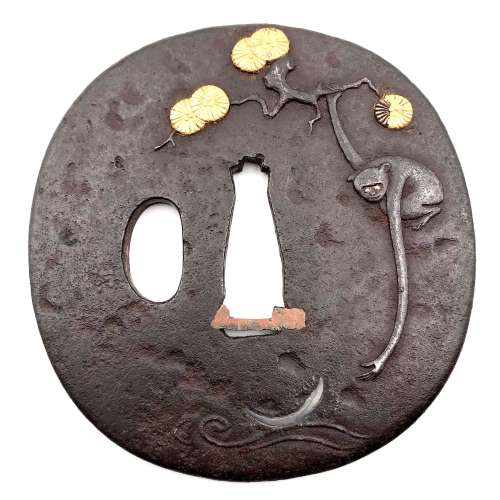 [SOLD]
[SOLD]Iron tsuba of slightly elongated round form carved and inlaid in gold and shibuichi with a long-armed monkey hanging from a pine tree branch reaching for the reflection of a crescent moon in the stream. A pine tree carved with details inlaid in gold on the reverse. The design seems to be inspired by Kaneie work (Compton III, p. 10, №6a; Tsuba no bi, 1947, p. 33, №56).
Dimensions: 76.8 x 74.2 x 3.6 mm. Mid-Edo period. Unsigned.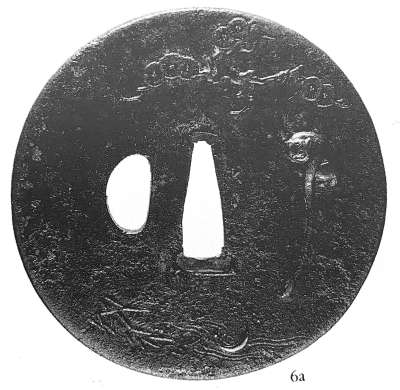
Compton III, p. 10, №6a

Tsuba no bi, 1947, p. 33, №56.
-
 Large and thin iron tsuba of round form (width > height) decorated with the design of a tiger sheltering in bamboo in suemon-zōgan brass inlay. A fragment of tail inlay is missing. Bamboo leaves on the reverse. According to Merrily Baird [Symbols, p. 166], tiger sheltering in bamboo symbolizes "weak giving shelter to the strong". Momoyama period. Unsigned. Dimensions: 90.8 x 91.2 x 3.4 (center), 3.1 (rim) mm. Custom wooden box. NBTHK Certificate № 4001593.
Large and thin iron tsuba of round form (width > height) decorated with the design of a tiger sheltering in bamboo in suemon-zōgan brass inlay. A fragment of tail inlay is missing. Bamboo leaves on the reverse. According to Merrily Baird [Symbols, p. 166], tiger sheltering in bamboo symbolizes "weak giving shelter to the strong". Momoyama period. Unsigned. Dimensions: 90.8 x 91.2 x 3.4 (center), 3.1 (rim) mm. Custom wooden box. NBTHK Certificate № 4001593. -

Small iron tsuba (tantō size) of aoi form with the design of paulownia leaves and blossoms in copper and brass flat inlay (hira-zōgan). Brass sekigane. Open kozuka hitsu-ana.
Early Edo period, 17th century.
Size: 53.4 x 40.7 x 4.4 mm; weight: 47.4 g
-

Bronze tsuba of mokkō form with narrow slightly raised rim carved in kebori with the sea weed and inlaid with a lobster (ebi) made of copper on the face and two sea shells made of shakudo on the back. Lobster's antennae inlaid in gold, and eyes inlaid in shakudo. Ishime-ji treated surface.
Unsigned.
Late Edo period (mid-19th century). Dimensions: 76.3 x 71.1 x 3.7 mm -
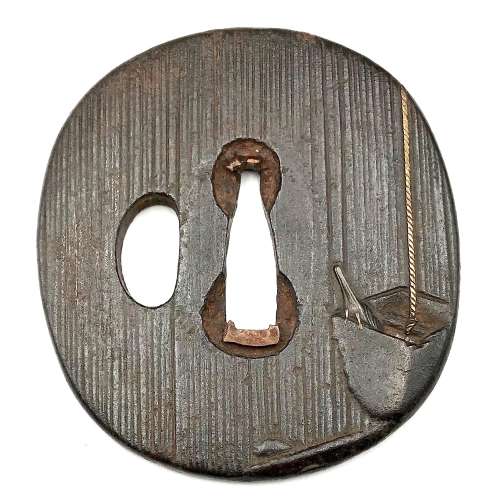
Iron tsuba of elongated round form with brown (chocolate) patina. The surface is carved with file strokes (sujikai-yasurime) to imitate heavy rain. The design of a bird drinking water from a bucket hanging on a rope is carved in low relief (sukidashi-bori); the rope is inlaid in gold. The well structure on the reverse, carved in low relief. Nakago-ana is enlarged and plugged with copper sekigane. Unsigned.
Edo period.Size: Height: 75.1 mm; Width: 68.3 mm; Thickness: 4.6 mm; Weight: 134 g.
Unsigned.
SOLD -

Small iron tsuba (tantō size) of oval form carved with imitation of six overlapping plates, decorated with paulownia blossoms, leaves, and tendrils in brass and copper hira-zōgan. Copper sekigane. Open kozuka hitsu-ana.
Early Edo period, 17th century.
Size: 50.5 x 34.0 x 4.9 mm.
-
 Copper (suaka) tsuba of oval form carved in relief, pierced and inlaid with soft metals (gold, shakudō, shibuichi or silver) with a cormorant fisherman (ushō) and moon motif on the face and a boat among the bank reeds on the reverse. Signed: Nagatsune. Box inscription: Tsuba with cormorant fishing, made by Nagatsune. Dimensions: 62.7 mm x 53.2 mm x 4.2 mm (at seppa-dai) Edo period: 18th century. Nagatsune (1721-1787), 1st generation master of Inchinomiya School in Kyoto, adopted son of the gilder Nagayoshi, student of Yasui Takanaga [M. Sesko 'Genealogies', p. 26]. Detailed account of the school is given at The Japanese toso-kinko Schools.// Lulu Inc., 2012 by Markus Sesko, pp. 104-108. Nagatsune's biographical sketch can be found there on pp. 104-106. "What Sōminis in the East (Edo), Nagatsune is in the West (Kyōto)." “Since Nara period, Japanese fishermen in small boats have used cormorants (u) to catch river fish at night, binding the necks of the birds so that the fish are not swallowed. […] The bird and the work it performs are symbols of selfless devotion to one’s master and keen eyesight.” – from Merrily Baird 'Symbols of Japan. Thematic motifs in art and design.' //Rizzoli international publications, Inc., 2001; p. 104. See also in this collection: TSU-241 and TSU-0096
Copper (suaka) tsuba of oval form carved in relief, pierced and inlaid with soft metals (gold, shakudō, shibuichi or silver) with a cormorant fisherman (ushō) and moon motif on the face and a boat among the bank reeds on the reverse. Signed: Nagatsune. Box inscription: Tsuba with cormorant fishing, made by Nagatsune. Dimensions: 62.7 mm x 53.2 mm x 4.2 mm (at seppa-dai) Edo period: 18th century. Nagatsune (1721-1787), 1st generation master of Inchinomiya School in Kyoto, adopted son of the gilder Nagayoshi, student of Yasui Takanaga [M. Sesko 'Genealogies', p. 26]. Detailed account of the school is given at The Japanese toso-kinko Schools.// Lulu Inc., 2012 by Markus Sesko, pp. 104-108. Nagatsune's biographical sketch can be found there on pp. 104-106. "What Sōminis in the East (Edo), Nagatsune is in the West (Kyōto)." “Since Nara period, Japanese fishermen in small boats have used cormorants (u) to catch river fish at night, binding the necks of the birds so that the fish are not swallowed. […] The bird and the work it performs are symbols of selfless devotion to one’s master and keen eyesight.” – from Merrily Baird 'Symbols of Japan. Thematic motifs in art and design.' //Rizzoli international publications, Inc., 2001; p. 104. See also in this collection: TSU-241 and TSU-0096The design was popular among the tsuba makers. We find one in the Alexander G. Moslé collection [Japanese Sword Fittings from the Alexander G. Moslé Collection; Sebastian Izzard LLC, 2004, page 90, №123] signed Nagatsune with kaō: Tsuba with cormorant fisherman, moon, and boat. Squared-oval shibuichi plate, slightly raised rim, engraved, pierced, and inlaid with soft metals in relief. 6.7 x 5.8 cm.

Alexander G. Moslé collection №123.
Another reference: Lundgren Collection, 1990, page 86 №207: Sword guard with design of ushō (person who fishes with cormorants). Signed by Nagatsune. Ichinomiya school. 6.45 x 5.95 x 0.40 cm. Polished shibuichi taka-bori relief, gold and silver inlay. Edo period, 18th century.

Lundgren Collection №207:
-
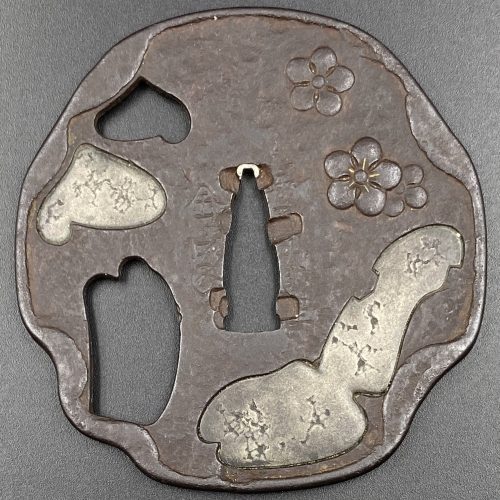
A very thin kobushi-gata form iron tsuba decorated in openwork (sukashi), some openings filled with grey metal (silver or pewter) treated in a way to resemble cracked ice, ginkgo leaf to recto and plum blossoms to verso in low-relief (takabori) and gold inlay (zōgan), and unevenly folded over rim (hineri-mimi). The overall theme of the piece is linked to the icy ponds, falling ginkgo leaves and blossoming plums in the late winter.
Size: 84 x 80 mm, thickness (center): 2 mm.Signed: Yamashiro no kuni Fushimi no ju Kaneie [Kaneie of Fushimi in Yamashiro Province] [山城國伏見住金家], with Kaō.
Probably the work of Meijin-Shodai Kaneie (c. 1580 – 1600).
The silver or pewter inlays likely a later work that may be attributed to Goto Ichijo (1791 – 1876) or one of his apprentices in the late 19th century, possibly as a tribute to the great Kaneie masters. Here is an article by Steve Waszak dedicated to Kaneie masters and this tsuba in particular.Kaneie
For many tosogu aficionados, this name reigns supreme among all tsubako across Japanese history. The first Kaneie is celebrated for many things. He is recognized as being the first ever to bring pictorial landscape subjects to a canvas so small as that of a tsuba plate. His skill in being able to render classical Chinese landscape themes while working with a material as unyielding as steel, and to do so with the sensitivity he does, is nothing short of astounding. The quality of his workmanship — especially that of his exquisitely carved motif elements and the extraordinary deftness of his tsuchime (槌目 or 鎚目, hammer-blow) utilizing such thin plates — astonishes even to this day. His sensibilities concerning the shaping of his sword guards and the presentation of the rims were no less innovative than his subject matter. He was among the very first to regularly sign his name as a tsuba smith. And it is likely that he served the great warlord Toyotomi Hideyoshi in the latter years of the 16th century. Despite the great fame and reputation of Kaneie, very little of the lives of the two men who are seen by most scholars as the “true Kaneie” tsubako of the Momoyama and earliest Edo Periods is known to us now. They were both smiths working in steel, with occasional added soft-metal inlay (usually serving to highlight features), and both made sword guards of the same style, using subject matter focused on landscapes, allusions to historical events, or religious themes. The first of these men is often referred to as “O-Shodai,” or Great First Generation, while the second is known as “Meijin-Shodai,” or Famous First Generation. While some see subsequent generations stemming from these first two men, others have the O-Shodai and the Meijin-Shodai as THE two true Kaneie and make a sharp distinction between these two smiths and any others who may share the name.The work of the O-Shodai may appear with two different mei. One of these is written “Joshu Fushimi Ju Kaneie,” while his work may also carry a mei reading “Yamashiro no Kuni Fushimi Ju Kaneie.” It is thought by some scholars that the earlier works present with the “Joshu” mei, while his later works feature the “Yamashiro” mei. However, there are only some five or six tsuba extant with the “Joshu” signature, so we should not necessarily see works with the “Yamashiro” signature as dating only to the latest years of his working life. The answers to the questions of exactly when Kaneie might have begun his life as a tsubako, or how old he was when he moved to sign his works with the “Yamashiro” mei, will probably remain shrouded in uncertainty.The association between Kaneie and Toyotomi Hideyoshi is speculative, to be sure, but the circumstantial evidence is tantalizing. The area of Fushimi is thought to have been an entirely unremarkable land prior to Hideyoshi’s building of a castle there, so it would seem unlikely that the first Kaneie would have been working in such a nondescript place, much less including the place name in his mei, before Hideyoshi’s putting it on the map, so to speak. Why emphasize such pride of place in one’s signature unless the place itself carries a certain weight? The name “Kaneie” translates roughly to “gold family,” which, given Hideyoshi’s notorious love of gold, would seem too much of a coincidence when combined with the explicit mention of Fushimi in the signatures. Combine this with the consideration of what is an equally compelling relationship between the celebrated tsubako Nobuie and Oda Nobunaga (“Nobuie” means roughly “of the family of “Nobu”), whom Hideyoshi served as a top general until Oda’s demise in 1582, and the circumstantial evidence becomes even harder to deny the plausibility of. Oda, ever the innovator, may have been the one responsible for birthing the practice of tsubako regularly signing their works. Having a superb smith like Nobuie affix the name to the tsuba as a regular practice establishes a sort of “brand name,” a brand coming with the seal of approval of Oda Nobunaga. It is more than possible that Nobunaga may have then used these valuable sword guards as rewards given to vassals and other important relations to honour them for their services to him, a practice that would have allowed Nobunaga to avoid having to use gold, guns, swords, horses, or land to do so. The awarding of a magnificent Nobuie tsuba to a deserving warrior, an appreciated ally, or a family member would bring honour to the recipient, of course, but would also honour the maker of the sword guard, and even the giver of the object. Such a way of thinking would be absolutely typical of him, and given that both Oda Nobunaga and Nobuie were men of Kiyosu in Owari in the early Momoyama Period, it does not strain credulity to imagine that the above dynamic could have occurred in just this way. If indeed it did, Toyotomi Hideyoshi is unlikely to have let this pass unnoticed. He may even have been so honoured himself! When he rose to power very shortly after Oda’s death, then, and when he reinforced and consolidated that power in the late 1580s and early 1590s, which included the building of the castle at Fushimi, perhaps he sought to emulate the Oda vision and practice of establishing a “royal tsubako.” If so, Kaneie would have been that smith.As noted, this scenario is speculative, and not a little romantic. This does not mean, however, that it is in fact not likely, for there would be a number of coincidences involved for it to be entirely false.Tsuba scholars will say that Kaneie’s skills in the making of his sword guards indicate an armour-making background. This is an interesting viewpoint, but one can’t help but wonder how many armourers were possessed of such fluent literacy in lyrical Chinese historical tales that they could then represent them as motifs on steel plates. Kaneie subjects often are in the form of Chinese landscapes and allusions, as noted, one of which — The Eight Views of the Xiao and the Xiang — was very well known as a famous subject of Chinese painting and poetry from the Song Dynasty. There exist Kaneie tsuba which depicts at least some of these “views,” and it seems unlikely that if one or more of them were to be created, not all of them would be, in a sort of “series.” The cultural and literary fluency Kaneie would seem to have had, then, may suggest a Buddhist background, and indeed, some of the subjects seen are explicitly Buddhist in nature. Perhaps his background then, somehow offering a dovetailing of metalwork and Buddhist teachings; in any event, we are all the richer for at least some of the works of Kaneie to have survived to reach us today.One of the hallmarks of Kaneie tsuba (real ones) is the extreme thinness of the plate, combined with utterly superb tsuchime expression of that plate. To be able to hammer the plate to achieve such strength of expression while the plate is so thin is seen by the Japanese as practically miraculous. A notable and important kantei point between the early masterpieces by the two “Shodai” Kaneie and the tsuba made by followers is this thinness of the plate. Another kantei point: because the plate is so thin when raised areas representing motif elements are present, they are inlaid into the plate, because trying to carve them from such a thin plate would be practically impossible: the likelihood of piercing the plate would be high, and the plate in that area, even if not pierced, would be significantly weakened by trying to manage the raising of a motif element from the plate. In real Kaneie works, then, one would expect any raised motif elements to be inlaid.Other highlights: the “Shodai” Kaneie are famous for the kobushi-gata (拳形) or “fist-shaped” design in their work, but despite this, there actually aren’t that many extant sword guards boasting this shape. Another feature for which the Kaneie are justly famous is their folding over of the lip of the rim onto the plate in a very tasteful manner, just here and there, rather than uniformly across the tsuba. However, again, this feature is actually not commonly seen, either. The combination, then, of a kobushi-gata shape with the rim folded over in just a few areas is that much rarer.Which brings us to the featured piece.Here is a Kaneie tsuba, a “Meijin-Shodai” Kaneie, which presents with a very thin plate, being between 1.5 and 2mm in thickness. The motif elements are inlaid, as we should expect. The sugata (姿, shape) is Kobushi-gata with the rim folded over in only a few places, representing a relatively infrequently encountered form, as stated. The tsuba here is fortunate not to have any added hitsu-ana, unlike many or most other Kaneie do. The sukashi elements are fascinating to consider, being difficult to determine the meaning of; however, the raised elements clearly point to a seasonal motif, with cherry and plum blossoms on the omote for Spring, and ginkgo on the ura for Fall. The inlaid metal in two of the openings — silver, shibuichi, or pewter, perhaps — is very likely a later addition, probably 19th-century, and more specifically, late-19th-century. The finishing on these inlaid portions has all the hallmarks of Goto Ichijo workmanship. Namely, the treatment of the surface of the inlay to resemble fallen snow (in the Japanese sense of things) is expressed in a very Ichijo sense of things, and, given the great importance of Kaneie tsuba, and the seasonal expression the motif of the guard has, it is plausible that the inlay is Ichijo work or that of one of his top students. In any event, this inlay complements the rest of the tsuba beautifully. The inlay also resembles the art of kintsugi (金継ぎ, golden joinery) or the Japanese practice of ceramic repair using lacquer when a piece is particularly special or important. In this way, a nod is given to Tea Culture, too, creating a wonderful blending of associations and allusions, typical of the highest Japanese aesthetic sense.At 8.4cm, the tsuba is of an excellent size and is in great condition (no rust, no deep rust pitting, no fire damage). There is, intriguingly, one small sign of battle damage at 6:00 on the guard: it would seem a sword blow cut into the tsuba at the rim, and penetrated slightly into the plate. The superb repair represented by a little stitch or two right at the rim and along a few millimetres of the plate is visible on very close inspection. The repair is old, probably nearly contemporary with when the tsuba was made. Given the high status of Kaneie in their lifetime (as tsubako for Hideyoshi, one might imagine their importance), and given the obvious high quality of this piece, it is not surprising that the finest repair efforts were put into its care.The name Kaneie justly enjoys its fame and accolades as pre-eminent among the tens of thousands of tsubako in Japanese history. We are fortunate indeed to have had a small number of the works of the early masters survive to this day. The first of their kind, and as most scholars and aficionados would wholeheartedly agree, the best of their kind, Kaneie sword guards remain among the very finest examples of the Japanese metal-working traditions. -
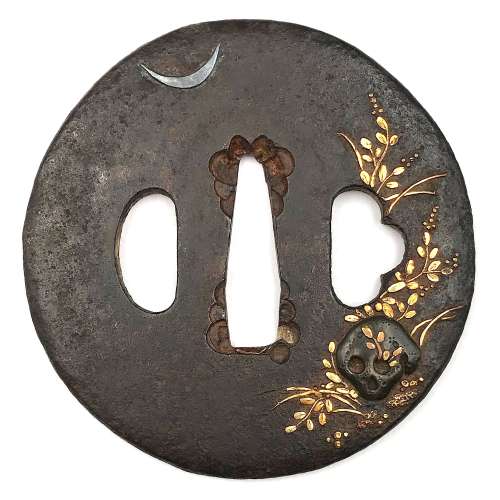 An iron tsuba of round shape inlaid with shakudō, gold, and silver with a motif of a weather-beaten (nozarashi) skull and grasses growing beside as well as through the eye-pit, and a crescent moon above the scene. Grasses on the reverse. Unsigned. Dimensions: 71.7 x 70.6 x 4.2 mm Reference: Skull, bones and grave markers SOLD
An iron tsuba of round shape inlaid with shakudō, gold, and silver with a motif of a weather-beaten (nozarashi) skull and grasses growing beside as well as through the eye-pit, and a crescent moon above the scene. Grasses on the reverse. Unsigned. Dimensions: 71.7 x 70.6 x 4.2 mm Reference: Skull, bones and grave markers SOLD -
 Iron tsuba decorated with sparrows and bamboo inlaid and chiseled in yellow brass, with snow lying on bamboo leaves inlaid in silver-ish shibuichi. Copper sekigane. The kogai-hitsu-ana probably cut out at a later date. Heianjō school. Unsigned. Height: 86.0 mm, Width: 85.4 mm, Thickness at seppa-dai: 2.9 mm. Momoyama or early Edo period, first half of the 17th century. Merrily Baird, Symbols..., page 118: "The association of the sparrow (suzume) with both bamboo and rice heads is an old one found in Japanese poetry, paining, and design."
Iron tsuba decorated with sparrows and bamboo inlaid and chiseled in yellow brass, with snow lying on bamboo leaves inlaid in silver-ish shibuichi. Copper sekigane. The kogai-hitsu-ana probably cut out at a later date. Heianjō school. Unsigned. Height: 86.0 mm, Width: 85.4 mm, Thickness at seppa-dai: 2.9 mm. Momoyama or early Edo period, first half of the 17th century. Merrily Baird, Symbols..., page 118: "The association of the sparrow (suzume) with both bamboo and rice heads is an old one found in Japanese poetry, paining, and design." -
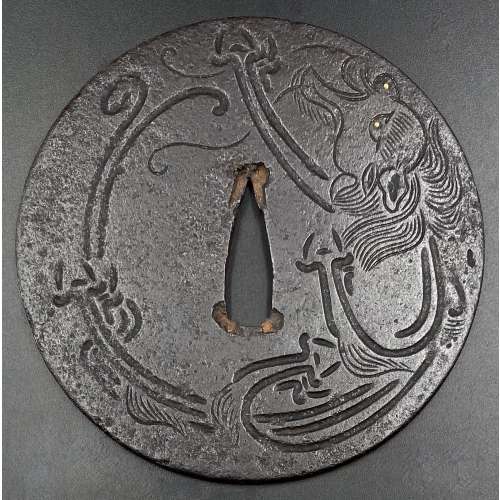 Iron tsuba of round form, on both sides decorated in low relief (kebori) with a dragon, eyes inlaid in brass. NBTHK: Hozon, № 4011013. Kamakura-bori type of tsuba. Med-Muromachi period, c. 1450. Diameter: 90 mm; Thickness (centre): 3.3 cm, Thickness (rim): 2.4 cm Reference: Japanese Swords and Sword Fittings from the Collection of Dr Walter Ames Compton (Part I). — NY: Christie's, 1992, p. 10, №2. Obviously, Compton's tsuba has an altered nakago-ana and placed on the photo upside down. Compton's tsuba has a raised mimi, while mine does not.
Iron tsuba of round form, on both sides decorated in low relief (kebori) with a dragon, eyes inlaid in brass. NBTHK: Hozon, № 4011013. Kamakura-bori type of tsuba. Med-Muromachi period, c. 1450. Diameter: 90 mm; Thickness (centre): 3.3 cm, Thickness (rim): 2.4 cm Reference: Japanese Swords and Sword Fittings from the Collection of Dr Walter Ames Compton (Part I). — NY: Christie's, 1992, p. 10, №2. Obviously, Compton's tsuba has an altered nakago-ana and placed on the photo upside down. Compton's tsuba has a raised mimi, while mine does not.
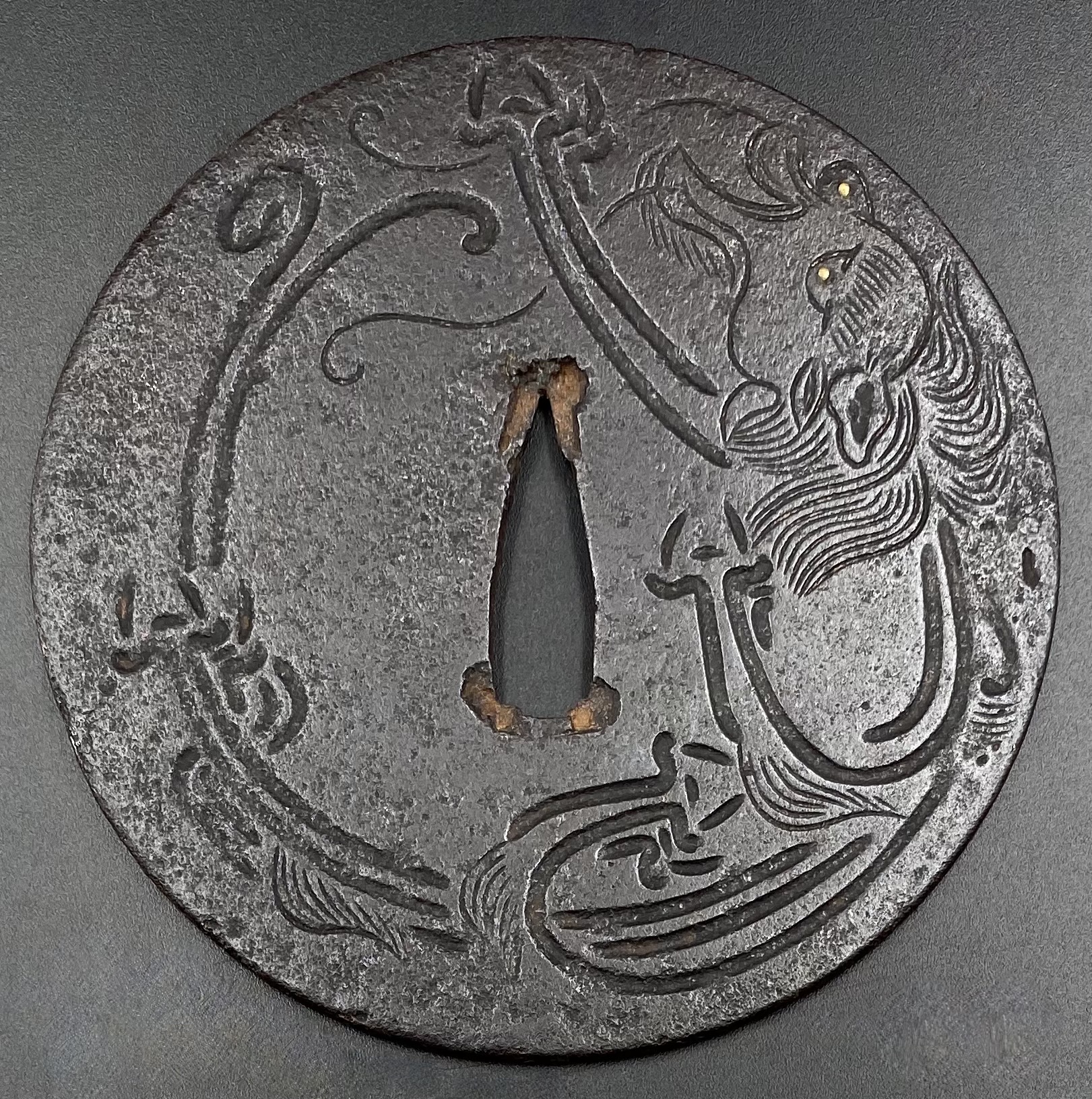 Two other examples of the same design may be found at: (1) Christie, Manson & Woods auction sales “Kotetsu”, 1980, page 12, №10 and (2) Professor A. Z. Freeman and the Phyllis Sharpe Memorial collections №36, pp. 18-19. Both have raised mimi, the latter classified as Katchushi tsuba.
More about Kamakura-bori tsuba here.
Two other examples of the same design may be found at: (1) Christie, Manson & Woods auction sales “Kotetsu”, 1980, page 12, №10 and (2) Professor A. Z. Freeman and the Phyllis Sharpe Memorial collections №36, pp. 18-19. Both have raised mimi, the latter classified as Katchushi tsuba.
More about Kamakura-bori tsuba here.
-

Iron tsuba of oval form with a shakudō fukurin and rough surface decorated by low relief carving and brass inlay with a centipede emerging from under the rock on both sides.
Edo period.Size: 78.9 x 73.6 x 3.8 mm
Unsigned. However, this tsuba may be (though with reservation) attributed to Misumi Kōji school. There is some information regarding this master(s) in Tsuba. An aesthetic study by Kazutaro Torigoye and Robert E. Haynes (from the Tsuba Geijutsu-kō of Kazataro Torigoye. Edited and published by Alan L. Harvie for the Nothern California Japanese Sword Club, 1994-1997) on pages 163-4, though I was not able to locate the tsuba in the original publication. Possibly, this fragment of the book was added by Robert Haynes. Markus Sesko speculates about Misumi in his The Japanese toso-kinko Schools.// Lulu Inc., 2012 on pages 374-5: "Misumi Kōjo Tsuba. Iron plate, elliptical shape, shakudō takabori suemon, yamagane fukurin. Centipede." But of course, visual similarity does not prove anything. I was not able to find any traces of signature or a triangle on the seppa-dai.
Misumi Kōji Tsuba on p. 163.
-
 Shibuichi Kozuka carved in low relief (takabori, usuniku-bori) and inlaid in gold and silver with design of Shoko, reading by moonlight, thatch, pine rosettes, and fool moon. According to Henri L. Joly [LEGEND IN JAPANESE ART. London, 1908; LIB-1416 in this collection] Shoko was a Chinese student of Taoism who was so poor that he had no money to buy illuminating materials and read by moonlight. Shoko mentioned in the article about another Chinese character - Shaen, who was reading by the light emitted by glow-worms (see page 310). Signed on the back: Haruchika (春親) + kaō. Size: 97.3 mm (H) x 14.8 mm (W). Edo period, mid 19th century. NBTHK Certificate № 449542. Hamano Haruchika from Edo was a student of Haruyuki in 1848-54; Hamano School, Etchū Toyama Branch, according to M. Sesko's "Genealogy", page. 34. Most probably it is his work. Following the MFA data, it is also possible that "our" Haruchika is indeed Nara Haruchika or Tsuchiya Haruchika from Nara School; though I did not hind such artist in Markus Sesko books. However, in his "Toso-Kinko" on page 177 there is certain Shingorō who carried out his business under the name of Yanagawa Haruchika (1791-1857?)
Shibuichi Kozuka carved in low relief (takabori, usuniku-bori) and inlaid in gold and silver with design of Shoko, reading by moonlight, thatch, pine rosettes, and fool moon. According to Henri L. Joly [LEGEND IN JAPANESE ART. London, 1908; LIB-1416 in this collection] Shoko was a Chinese student of Taoism who was so poor that he had no money to buy illuminating materials and read by moonlight. Shoko mentioned in the article about another Chinese character - Shaen, who was reading by the light emitted by glow-worms (see page 310). Signed on the back: Haruchika (春親) + kaō. Size: 97.3 mm (H) x 14.8 mm (W). Edo period, mid 19th century. NBTHK Certificate № 449542. Hamano Haruchika from Edo was a student of Haruyuki in 1848-54; Hamano School, Etchū Toyama Branch, according to M. Sesko's "Genealogy", page. 34. Most probably it is his work. Following the MFA data, it is also possible that "our" Haruchika is indeed Nara Haruchika or Tsuchiya Haruchika from Nara School; though I did not hind such artist in Markus Sesko books. However, in his "Toso-Kinko" on page 177 there is certain Shingorō who carried out his business under the name of Yanagawa Haruchika (1791-1857?) -
 Iron tsuba of round form inlaid with brass, copper, and shakudō wire fastened to the surface with metal staples (mukade-zōgan); Scalloped brass inlay around the rim. Early Edo, 17th century. Height: 84.8 mm; Width 84.8 mm; Thickness at seppa-dai: 3.7 mm. Weight 161.6 g. Design is thought to resemble a centipede. "Centipede-like inlay (mukade zogan) of alternating iron and brass staples produce an appearance that was particularly favored by Takeda Shingen (1521-1573), one of the most powerful warlords of his time. The centipede is sacred to Bishamon (God of War) and especially propitious for a warrior. Shingen type, 16th century.” [The Peabody Museum collection of Japanese sword guards with selected pieces of sword furniture, by John D. Hamilton. Photographs by Mark Sexton. Salem, MA, 1975.] See also: http://varshavskycollection.com/shingen-tsuba/
Iron tsuba of round form inlaid with brass, copper, and shakudō wire fastened to the surface with metal staples (mukade-zōgan); Scalloped brass inlay around the rim. Early Edo, 17th century. Height: 84.8 mm; Width 84.8 mm; Thickness at seppa-dai: 3.7 mm. Weight 161.6 g. Design is thought to resemble a centipede. "Centipede-like inlay (mukade zogan) of alternating iron and brass staples produce an appearance that was particularly favored by Takeda Shingen (1521-1573), one of the most powerful warlords of his time. The centipede is sacred to Bishamon (God of War) and especially propitious for a warrior. Shingen type, 16th century.” [The Peabody Museum collection of Japanese sword guards with selected pieces of sword furniture, by John D. Hamilton. Photographs by Mark Sexton. Salem, MA, 1975.] See also: http://varshavskycollection.com/shingen-tsuba/


